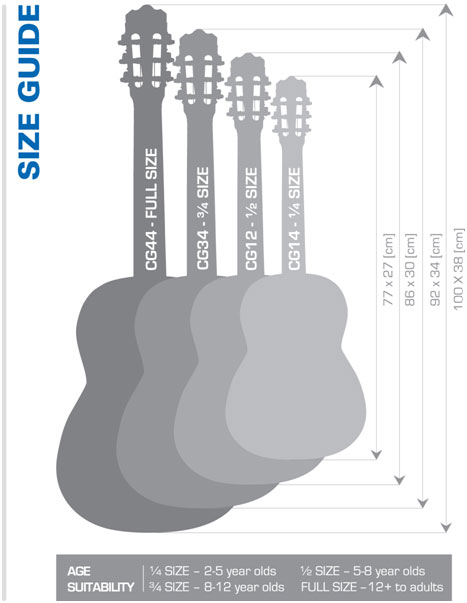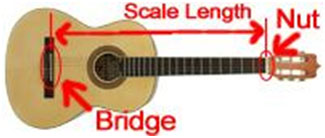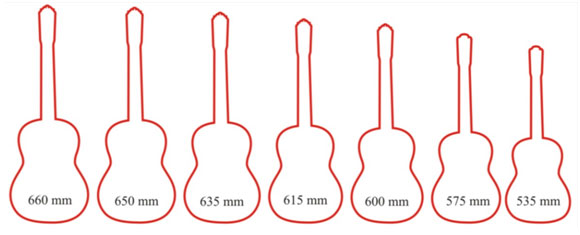Guitar Sizing Guide
| Average Age | Height of Player | Size of Guitar |
| 2-5 years old | 3’3″ to 3’9″ | 1/4-Size |
| 5-8 years old | 3’10” to 4’5″ | 1/2-Size |
| 8-12 years old | 4’6″ to 4’11” | 3/4-Size |
| 12-Adult | 5′ or taller | 4/4-Size |
Note: This chart is a guide and does not take into account factors such as arm length, hand span, and finger length. Keep reading for additional information.
1/2 Guitar
A 1/2 size guitar would be ideal for an age of 5 through 8, or anyone who is around 4’ tall.
Note: Also, if a child was 4 years old, but near 3’10” tall, it might also be a good decision to go ahead and invest in the 1/2 size guitar.
3/4 Guitar
This 3/4 size guitar would be a suitable for an average age of 8 though 12, or anyone that is between 4’6” and 4’11” tall.
Note: Any individual under 6’ tall may also prefer a smaller size guitar. In this case, someone closer to 5’ tall might prefer a 3/4, or even a 7/8 size guitar. Arm length, shorter fingers, and hand span, should also be considered before moving to a full-size guitar.
Full-Size Guitar (by 20th century standards)
Upon moving to a full-size guitar, it is often up to the preference of the player, or discretion of the instructor. The player can often tell what would be a comfortable size. On average, a full size guitar is comfortable for those around 5’ or taller.
Again, the decision to use a full-size guitar is up to the player and their perceived comfort upon playing the instrument.
Other Factors
Scale-length – the basic distance between the nut and the bridge’s saddle. This measurement is determined by the luthier (guitar-maker) for fret placement, string tension, tone, and intonation. It will differ naturally due to the size of the guitar. The standard scale length for a modern full-size classical guitar is 25.6 inches (650mm). A slightly smaller scale length favors shorter fingers and hand span.
Note: Many guitarists around 5’ tall play a guitar with a scale length of 640mm
Neck Width – A wider fretboard may make it easier to precisely finger notes on the strings because the strings will be farther apart, but it may also be harder for small hands to get around the neck. The radius of the neck is determined by the measurement of the radius on the back of the neck. This measurement will give you an idea of how thick the neck is. If you have small hands, you will probably want a small radius neck. On the 1/4, 1/2, 3/4 size guitars, the necks all have radiuses that are appropriate for the intended player. The width and radius of the neck is usually only a factor on full-size guitars where experienced players have a good idea of the size of neck that is comfortable for them. It should be noted that classical guitars invariably have wider necks.

Children’s Guitar Sizing Guide : In Detail
(Condensed article: www.suzukidad.com)
If you want to give your child the best chance to succeed at learning the guitar, buy a guitar that is playable, decent quality, and the right size. The guitar will almost certainly cost more than you think you should spend for a child’s first guitar, particularly if you’re starting lessons at 4 or 5 years old.
Here’s a universal truth of music education:
A beginning student has a greater need for a good instrument than an advanced player does.
This makes sense, if you think about it: An advanced player can work around a bad instrument’s flaws, but a beginning student has a hard enough time learning the basics. How can he/she learn to play if the instrument is fighting them?
Further, a student learning on a badly sized guitar will likely develop bad technical habits that will interfere with playing and will have to be unlearned. What’s worse, those bad technical habits can lead to injury.
In short, getting a decent, playable, right-sized instrument is important.
Fractional Guitars
Small guitars are also known as “fractional” guitars because they are designated by fractions, from 1/8 (the smallest) up to 7/8.
Unfortunately, you can’t entirely rely on these size designations, because their meaning (like the meaning of clothing sizes) varies from one guitar maker to another. Instead, you need to look at a guitar’s actual measurements.
The three measurements that matter, from most to least importance, are:
1. Scale length (the distance from nut to saddle)
This determines a guitarist’s left hand/arm position. The wrong scale length will cause awkward bending at the wrist. A standard classical guitar has a 650 mm scale length (25.6 inches).
(Note: Left handed guitarists may choose to use a left handed guitar. In this case, your fretboard hand will be your right hand)
2. Nut width
This determines two things: (1) the position of the fingers on the guitarist’s left hand, and (2) the amount of space for the fingers on the right hand. If the nut is too wide, the left-hand fingers will have to stretch too far, which will create intonation problems. If the nut is too narrow, the right-hand fingers will not have as much room to move, and it may be harder to get clean individual notes. (Strings on a classical guitar are further apart than those on a steel-string guitar precisely to allow more room for the right-hand fingers.)
3. Box depth
This determines the guitarist’s right hand/arm position. A too-deep box will push the hand out too far.
Fitting a Child to a Guitar
There’s only one sure way to know if a guitar fits a child: Have the child try it out! A qualified teacher will be able to tell whether the guitar fits.
As a rough guideline for picking the right scale length, measure your child from the floor to the belly button, and consider a guitar with a scale length in this table:
| Child, from floor to belly button | Guitar scale length |
| 24 inches | 40 cm (400mm) |
| 26 inches | 45 cm (450mm) |
| 28.5 inches | 50 cm (500mm) |
| 33.5 inches | 55 cm (550mm) |
| 35.5 inches | 60 cm (600mm) |
| 36.75 inches | 63 cm (630mm) |
| Higher | Full-size (65 cm) (650mm) |
HOW TO MEASURE SCALE LENGTH:

ADDITIONAL SCALE LENGTHS THAT YOU MAY FIND:

Types Of Guitar
Many guitarists own several guitars, often of various types, and this is necessary if you want to play in a variety of styles (rock, classical and country music all require different types of guitar). But when you’re just starting to learn, it’s best to choose one type of guitar and stick with that until you’ve mastered the basics. It is recommended to start on a classical (nylon string) guitar, as this guitar is similar to the original guitar. The major guitar types are:
- Classical Guitar (Nylon String) – the classical guitar is normally a bit smaller than a steel string acoustic, and has nylon strings, which give it an attractive warm, mellow tone with a long sustain (steel strings should never be used on a classical guitar, as they can damage the neck). The classical guitar is played by using the fingernails to pluck the strings, and very complex and expressive melodies are characteristic of this style. Much of the classical guitar repertoire is written using notation, so learning to read notes is inevitable.
- Acoustic Guitar (Steel String) – acoustic guitars do not need an amplifier; instead they have a resonant body cavity that amplifies the sound of the strings without any external help. Steel-stringed acoustic guitars are often louder than their nylon-stringed counterparts and are often used to provide accompaniment. They can also be used for solo music as well. Steel string guitars are usually played with a pick (plectrum), but many players also use fingerstyle techniques on these guitar as well.
- Electric Guitar – guitars of this type make very little sound on their own; instead the sound is the result of electrical amplification. When buying an electric guitar, you’ll also need an amplifier – many beginner model electric guitars come with a small practice amp, or you can buy one separately. Electric guitarists also use accessories such as various effects pedals. (Note: Classical, Flamenco, and Acoustic guitars can also contain internal/external electronics for amplification if desired.)
- Flamenco Guitar – the flamenco guitar looks similar to the classical guitar, but is usually slightly smaller. It’s also made from different types of wood, which gives it a somewhat brighter tone. Another feature of the flamenco guitar is the plastic tap plate (or golpeador), which provides protection to the guitar body when the player is tapping on the wood to produce percussive effects (an important element of flamenco style). Traditionally, the flamenco guitar was used to accompany flamenco dancers and singers, but nowadays it’s commonly used as a solo instrument also.
To learn about guitar manufacturers or guitar builders (luthiers), please contact Shepherd Guitar Studio before making your purchase.




